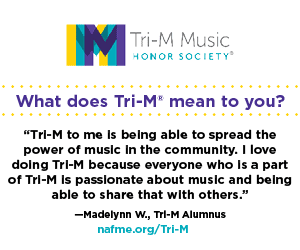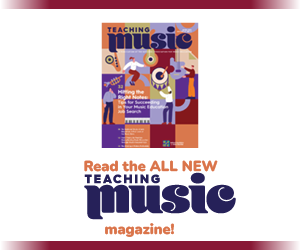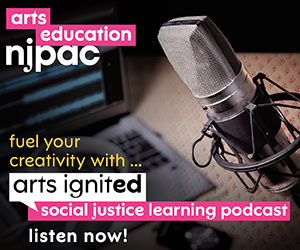/ News Posts / Harnessing Social Media for Music Education
Harnessing Social Media for Music Education
Opportunities and Strategies
By Denis Vasenin, M.M., and José Valentino Ruiz, Ph.D., University of Florida
This article underscores the importance of social media mastery for music educators, illustrating how strategic use can amplify career opportunities. It distinguishes between entertainment, educational, and infotainment content, noting that while entertainment attracts broader audiences, it often leads to superficial engagement. Educational content fosters deeper connections and enhances credibility, whereas infotainment blends learning with enjoyment. The piece emphasizes quality over quantity in content strategy and discusses the importance of selecting the right platform based on target audience demographics.
The Indispensable Role of Social Media Mastery for Music Educators
Have you ever reached that climactic final note of a musical piece you’ve painstakingly perfected, recorded, or composed, only to find yourself pondering how to share it with the world? Or perhaps you did share it, only to be met with a tepid response, leaving you disheartened by the lack of engagement despite your significant efforts. Unfortunately, this scenario is all too common among musicians, often leading to frustration and self-doubt. The tendency is to attribute such outcomes to insufficient practice, a lackluster melody, or a composition that doesn’t quite resonate. Yet, it’s crucial to re-evaluate this perspective. What if the true barrier to realizing your musical aspirations isn’t the quality of your work, but rather a missing element in your professional toolkit—specifically, the strategic use of social media?
Imagine that by honing your social media skills, you could unlock significant opportunities with just a bit of effort. The advice to create a website and start an email list is now considered basic; today’s landscape demands more. Social media has eclipsed traditional search engines as the primary driver of traffic, with platforms like YouTube, Instagram, and TikTok becoming essential tools for visibility. Reflect on your own habits: Do you spend more time on social media or on search engines? The potential of social media is often underestimated, viewed merely as a vehicle for viral trends. However, for those striving for recognition, social media is an indispensable tool that can significantly amplify your reach and impact. This democratization of storytelling on the internet has replaced the need for approval from traditional “media gatekeepers” such as newspaper editors or TV networks, presenting both unprecedented opportunities and challenges in an intensely competitive global arena.
Therefore, it’s imperative that music educators not only understand the importance of social media but also effectively communicate its necessity to their students. Educators are uniquely positioned to guide students in leveraging social media as a strategic asset rather than merely a platform for personal expression. Continuously mastering these tools, students can enhance their visibility and carve out meaningful careers in an ever-evolving music industry. This knowledge is crucial, not only for personal success but for adapting to the continually shifting paradigms within the music profession.
Strategic Content Creation: Case Study of the 2024 Guitar Festival
Last year, while leading the promotional efforts for the University of Florida (UF) Guitar Festival and Competition, I oversaw the creation of 15 videos and the distribution of instructional infographics on Instagram. Our strategy included active audience engagement through direct messaging and content resharing, which yielded remarkable results: more than 700 new subscribers and 70,000 views in just two months. More significantly, compared to the previous year, we experienced a 160% increase in festival attendance, an elevated level of competition and status, and a 40% rise in applications to the UF Guitar program—all achieved without any paid advertising. This success poses a critical question: Could such outcomes be realized through any other form of free media? The answer is unequivocally no.
As we explore the journey of content creation, it is essential to understand the varied impacts of different content types—Entertainment, Infotainment, and Education. Each category serves a distinct role within the digital landscape, influencing how we engage with and connect to our audience. Entertainment content captivates attention and fosters emotional connections, Infotainment blends education with entertainment to inform while engaging, and Educational content provides deep, value-driven insights. Together, these content types create a comprehensive strategy that enhances visibility and fosters meaningful interactions, ultimately driving success in the digital age.
The Dynamics of Content Types in Digital Media:
Entertainment, Education, and Infotainment
Humor’s universal appeal undeniably serves as a powerful tool for expanding reach, given that nearly everyone enjoys a good laugh. Whether through trending memes, modern sounds, or bold antics, the aim of entertainment-style content is to capture attention quickly. However, it is important to recognize that such content often encourages shallow and brief interactions. For instance, while a humorous meme may attract viewers for a quick laugh, it is generally less effective in guiding them toward more substantive or instructive content from the same creator.
In contrast, educational content, although it may attract a smaller audience, tends to engage individuals who are actively seeking new knowledge or solutions to specific challenges. This type of content is particularly well-suited for fostering deep, long-lasting relationships between a creator and their audience, making it invaluable for brands aiming to build authority and trust within their field.
Infotainment content, which blends educational value with entertainment, occupies a unique space between these two extremes. For example, behind-the-scenes videos not only reveal the intricacies of the creative process but also humanize the creators, thereby cultivating authenticity and relatability among viewers. This hybrid approach can be especially effective in maintaining viewer interest while delivering meaningful information, ultimately enhancing both engagement and credibility.
Emphasizing Quality over Quantity in Social Media Strategy for Music Educators
The ongoing debate between quality and quantity in social media content is particularly pertinent in the realm of education, where the rise of dynamic features like reels and shorts has significantly altered audience engagement. These formats are designed to quickly capture and retain viewer interest, with success measured by the depth of interaction—such as complete views, rewatches, likes, shares, and comments. These interactions are crucial because they prompt algorithms to prioritize content that successfully maintains audience attention. For music educators navigating this competitive digital landscape, the strategy for success is straightforward yet critical: Prioritize the production of high-quality content that engages students from beginning to end. While future lessons may delve into specific strategies for enhancing content engagement, it’s vital to emphasize that the effectiveness of educational content hinges more on its quality than on the frequency of posts. Content that fails to immediately engage viewers is unlikely to hold their attention for long, diminishing its educational impact.
For instance, consider a video that quickly amasses 7,000 views, far exceeding previous efforts. While this initial success might suggest a positive trend, subsequent videos may not replicate the same level of engagement, underscoring an important lesson: There is no automatic “snowball effect” in sustaining interest in educational content. Each post represents a distinct opportunity to captivate and educate your audience, reinforcing the need to prioritize quality over quantity. This focus ensures that each piece of content not only attracts attention but also fosters meaningful, lasting engagement, which is essential for effective education in the digital age.
Practical Applications in Music Education
Music educators can enhance their teaching methods by integrating social media strategies directly into their curricula, thereby equipping students with essential skills for today’s digital-first music landscape. One effective approach is through assignment creation, where students are tasked with producing short, informative videos on musical theories or instrument tutorials. Students learn to prioritize depth over quantity by emphasizing the importance of content quality—ensuring clarity, engagement, and educational value. This not only improves their understanding of the subject matter but also hones their ability to create impactful digital content.
Interactive projects can further enrich the learning experience by encouraging students to develop content that requires viewer participation, such as posing questions about music history or inviting interpretations of a piece. This approach not only boosts engagement but also teaches students the importance of using social media as a dynamic, two-way communication tool. Additionally, incorporating the analysis of successful social media campaigns into the curriculum can provide valuable insights. By studying what makes certain music-related posts effective, students can discuss and adapt these strategies to their own content creation efforts, enhancing their ability to create compelling posts.
Peer feedback sessions offer another layer of refinement, allowing students to present their content to classmates for constructive criticism before posting it online. This peer review process ensures that the content is both engaging and informative, increasing the likelihood of its success in reaching and resonating with a broader audience. Diligently integrating these strategies into their teaching, music educators not only deepen their students’ understanding of effective social media use but also prepare them to leverage these platforms as powerful tools for expanding their visibility and exploring career opportunities in the music industry. These skills are increasingly essential as students learn to navigate the complexities of digital communication and content creation, which are crucial for success in today’s music making and learning communities.
Strategic Platform Selection for Optimal Social Media Impact
Choosing the Right Platform
Selecting the appropriate platform for your content is a strategic decision that should be guided by both the nature of your content and the demographic profile of your target audience. For music producers aiming to capture the attention of a younger, trend-sensitive demographic, TikTok is an ideal platform. Its vast and highly engaged user base is particularly receptive to musical content, providing fertile ground for viral success and the rapid dissemination of new trends. Conversely, classical musicians who seek to connect with audiences in more formal settings, such as those who attend upscale events or concerts, may find Facebook to be a more suitable platform. Facebook tends to attract an older demographic that values traditional music forms and is more likely to engage in ways that translate into physical attendance at performances.
Leveraging Platform Strengths
Each platform offers unique strengths that can be leveraged to enhance your reach and impact. Instagram, favored by businesses and creatives alike, presents a highly competitive landscape. To stand out, musicians must not only share their performances but also engage creatively and consistently with their audience. This could include behind-the-scenes content, interactive stories, or aesthetically curated posts that align with their artistic identity, all of which help in fostering a deeper connection with followers. YouTube, on the other hand, is particularly advantageous for sharing long-form content. It is an excellent platform for detailed performances, comprehensive tutorials, or in-depth vlogs. The platform excels in storytelling and community-building, as it allows for prolonged video engagement, which in turn helps audiences develop a stronger connection with the creator.
The Importance of Content Creation and Engagement
Understanding the nuances of each platform is critical, but the most crucial step is to begin creating and sharing your videos. Active engagement in content production and distribution is essential for discovering what resonates with your audience, refining your creative approach, and gradually building a loyal following. Through consistent content creation and thoughtful platform selection, musicians can effectively navigate the digital landscape, optimizing their social media impact and expanding their reach within their target audiences.
Concluding Thoughts on Content Creation
Content creation is a dynamic, iterative process where each piece presents an opportunity to connect with your audience, gather feedback, and refine your approach. Social media is constantly evolving, marked by changes in algorithms and shifts in user preferences, making it essential to maintain an active, adaptable, and responsive presence. Sustained success in this environment requires a commitment to consistent content production that keeps you relevant and engaged with your audience. Through strategically selecting platforms that align with your goals and consistently creating quality content, you can effectively engage your audience, build your brand, and achieve your objectives in the ever-changing digital space.
About the authors:
Denis Vasenin, M.M. is a 2024 Global Music® Outstanding Achievement Award Winning Music Video Producer; Winner of the Erik Staie International Music Competition; and a Digital Content Strategist for the UF Music Business & Entrepreneurship program at the University of Florida School of Music. Vasenin is completing a Doctor of Musical Arts in Guitar Performance with a Cognate in Entrepreneurship. He specializes in the teaching of content creation for arts entrepreneurs.
Dr. José Valentino Ruiz is an accomplished artist with multiple accolades including numerous Latin GRAMMY® Awards, and EMMY® Award, and two International Academy of Digital Arts and Sciences’ Anthem® Award for Best Strategy in Education, Art, and Culture. He also founded and directs the UF Music Business & Entrepreneurship program at the University of Florida. His latest musical project is “Claude Bolling Goes Latin: Suite for Flute & Latin Music Ensemble,” a collaboration with noted Latin jazz drummer and percussionist Carlomagno Araya. The album is available on his website.
Interested in reprinting this article? Please review the reprint guidelines.
The National Association for Music Education (NAfME) provides a number of forums for the sharing of information and opinion, including blogs and postings on our website, articles and columns in our magazines and journals, and postings to our Amplify member portal. Unless specifically noted, the views expressed in these media do not necessarily represent the policy or views of the Association, its officers, or its employees.
Published Date
September 12, 2024
Category
- Careers
- Innovation
- Lifelong Learning
Copyright
September 12, 2024. © National Association for Music Education (NAfME.org)







